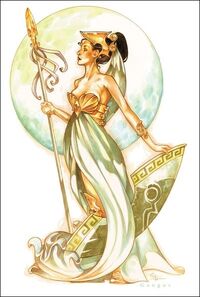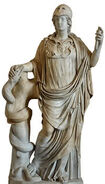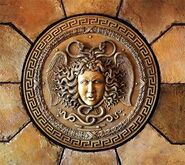| ||||||||||||||||||
|
| ||||||||||||||||||
Athena (alternately spelled Athene; Ancient Greek:Αθηνη) was the chaste Olympian of wise counsel, war, the defence of towns, heroic endeavour, weaving, pottery and other crafts. She is, above all, the Goddess of the City, the protectress of civilized life, of artesian activities, and of agriculture. She also invented the horse-bit, which, for the first time, tamed horses, allowing men to use them.
Most importantly, the goddess had a strong ethical component, as she was nearly unique among the Olympians for the fact that virtually no Greek mythic tales depicted her in an amoral or immoral light.
Athena was renowned for her role as a protector of cities and thus was worshiped in Hellenistic culture as Athena Polias ("Athena of the city"). In particular, she had a special relationship with the city of Athens, as can be shown by the etymological connection of the city with her name. In classical myth, she never had a consort or lover, and thus was additionally known as Athena Parthenos ("Athena the virgin"), a name that was enshrined in stone as the Parthenon, on the Acropolis in Athens.
Her symbol is the olive tree and her sacred animal then owl; her insignia is the Aegis, a shield with the head of a bronze Gorgon. The Romans equated her with their goddess Minerva. Unlike her Greek counterpart, Minerva was not a war goddess to the Romans, she acted as more of a strategic adviser and artist.
Etymology[]
In the pre-Hellenic world, it seems likely that Athena was a Minoan (or other non-Mycenaean) deity who achieved early prominence and was exported around the early Hellenic world for her role in defending the polis from hostilities. Numerous hypotheses have been put forward concerning the initial origin of her name, with some possibilities including a Lydian provenance, Crete, or a pre-Mycenaean syncretism between the Tyrrhenian "ati," meaning "mother" and the Hurrian Goddess "Hannahannah," which was shortened in various places to "Ana." In Mycenaean Greek, she is possibly referenced in a single inscription in the Linear B tablets, where A-ta-na-po-ti-ni-ja (Athana potniya) appears on a text from the Late Minoan II-era "Room of the Chariot Tablets" in Knossos, the earliest Linear B archive anywhere. Though this phrase is often translated as "Mistress Athena," it literally means "the potnia of At(h)ana," which could simply mean "the Lady of Athens." The ambiguity of this relationship is also attested to by Burkert (1985), who notes that "whether the goddess was named after the city or the city after the goddess is an ancient dispute."
Ephithets[]
In poetry from Homer onward, Athena's most common epithet is glaukopis (γλαυκώπις), which is usually translated "bright-eyed" or "with gleaming eyes." It is a combination of glaukos (γλαύκος, meaning "gleaming," "silvery," and later, "bluish-green" or "gray") and ops (ώψ, "eye," or sometimes, "face"). It is interesting to note that glaux (γλαύξ, "owl") is from the same root, presumably because of its own distinctive eyes. The bird that sees in the night is closely associated with the goddess of wisdom: in archaic images, she is frequently depicted with an owl perched on her head. In earlier times, Athena may well have been a bird goddess, similar to the unknown goddess depicted with owls, wings and bird talons on the Burney relief, a Mesopotamian terracotta relief of the early second millennium B.C.E. Other epithets include:
- Atrytone (Άτρυτώνη), the unwearying
- Athena Ergane (Παρθένος), the patron of craftsmen and artisans
- Athena Hippeia or Athena Hippia, the inventor of the chariot
- Parthénos (= virgin), the aspect of her character that was memorialized in the Parthenon
- Athena Polias ("of the city"), the protectress of the city (polis) - a name used in conjunction with Athens, Argos, Sparta, Gortyn, Lindos, and Larisa
- Promachos (Ή Πρόμαχος), the "pre-fighter," (i.e. the one who leads into battle).
Character and Function[]
Although certain scholars have seen in Athena a personification of moisture, analogous to the Hindu Sarasvati, it seems more probable that she was in origin a storm and lightning-Goddess. Hence her normal attribute, the aegis - which in primitive times signified the stormy night - and her epithet as a Goddess 'of the brilliant eyes'. She would thus be analogous to the Vedic Goddess Vach. But Athena very quickly lost this meteorological character.
Her functions are many: she is venerated among the great divinities in her quality of warrior-Goddess, as Goddess of the arts of peace and as Goddess of prudent intelligence.
To Athena the warrior - her oldest manifestation - belong the epithets Promachos ('who fights in the foremost ranks') and Alalcomeneis ('who repulses the enemy'). She is the protectress of towns and the guardian of acropolises.
The Pacific Athena protects various industries. She is preeminently the Ergane, or working woman, and is the patron of architects and sculptors, as well as of spinners and weavers. She also protects horses (Hippia) and oxen (Boarmia). The olive tree owed to her its fruit. Her wisdom, which earned her the epithet Pronoia (the Foreseeing), made her the counselor-Goddess (Boulaia) and the Goddess of the Assembly (Agoraia). Athena's emblem is the owl.
Mythology[]
Birth[]
Olympian version[]
In the Olympian pantheon, Athena was represented as the favorite daughter of Zeus, carried and birthed by her divine father without the necessity of any female intervention. The story of her miraculous birth comes in several versions. In the one most commonly cited, Zeus lay with Metis, the goddess of crafty thought and wisdom, but immediately feared the consequences. It had been prophesied that Metis would bear children more powerful than the sire, even if the father was Zeus himself. In order to forestall these dire consequences, Zeus "put her away inside his own belly" and "swallowed her down all of a sudden." Unfortunately, he was too late: Metis had already conceived a child. The Sky God, blind to the state of his now-consumed consort, resumed his life as usual. However, the ensuing period of normalcy came to an abrupt halt nine months later, when Zeus began to suffer cripplingly painful headaches. Trying to relieve the pressure in their ruler's cranium, one of the lesser gods (often Prometheus, Hephaestus, or Hermes) proceeded to cleaved Zeus's head with the double-headed Minoan axe. At this point, Athena leaped from his newly-opened skull, fully grown and armed, and "cried aloud with a mighty shout. The Sky [Ouranos] and mother Earth [Gaia] shuddered before her."
Other origin tales[]
Some origin stories tell of Athena having been born outside of Olympus and raised by the god Triton. Fragments attributed by the Christian Eusebius of Caesarea to the semi-legendary Phoenician historian Sanchuniathon, which Eusebius thought had been written before the Trojan war, make Athena instead the daughter of Kronos, a king of Byblos who visited 'the inhabitable world' and bequeathed Attica to Athena. Sanchuniathon's account would make Athena the sister of Zeus and Hera, not Zeus' daughter.
Athena Parthenos: Athena the Virgin[]
Unlike the majority of Olympian gods, Athena never had a consort or lover, and thus was also known as Athena Parthenos ("Virgin Athena"). Her most famous temple, the Parthenon, on the Acropolis in Athens takes its name from this title. This moniker was not merely an observation of her virginity, but recognition of her role as enforcer of rules of sexual modesty and ritual mystery. This role is expressed in a number of stories about Athena.
Erichthonius[]
The tale of the birth of Erichthonius is the most famous (and most sexually-charged) tale surrounding the virginal Athena. In it, the goddess is innocently traversing the site of the Athenian Acropolis when she is spotted by the misshapen (and sexually-repressed) Hephaestus. The smith-god, whose lust became instantly inflamed at the sight of the beautiful goddess, rushed to her side and attempted to rape her. Though she successfully repelled him, Athena was still struck in the leg by some of his seed. Repulsed, she wiped it off with a cloth and threw it to the ground. From there, it fertilized the earth and Erichthonius was born. Despite the child's illicit origins, Athena generously chose to raise it as a foster mother.
Erichthonius later became king of Athens and implemented many beneficial changes to Athenian culture. During this time, Athena frequently aided and protected him.
Medusa and Tiresias[]
Two other major episodes concern Athena and sexuality: one concerning the Gorgon, Medusa; the other, the blind seer, Tiresias.
The first tale, which has an etiological component, sets the stage by describing Medusa, stating that, unlike her two sister Gorgons, she was mortal and extremely beautiful. Unfortunately, she happened to have sex with—or be raped by—Poseidon in a temple of Athena. Upon discovering the desecration of her temple, Athena changed Medusa's form to match that of her sister Gorgons as punishment. Medusa's hair turned into snakes, her lower body was transformed, and her gaze became capable of literally petrifying any living creature that it rested upon.
In one version of the Tiresias myth, Tiresias stumbled upon Athena bathing, and was blinded by her nakedness. To compensate him for his loss, she sent serpents to lick his ears, which gave him the gift of prophecy.
Quarrel with Poseidon[]
Previously the Goddess had already shown particular benevolence to the land of Athens. In the days of King Cecrops a dispute had arisen between her and Poseidon for the possession of Attica. To affirm his rights Poseidon struck the rock of the Acropolis with his trident and a salt water spring gushed forth. According to another tradition it was a horse which appeared under Poseidon's trident. Athena, in her turn, caused an olive tree to sprout on the Acropolis, a tree which could be seen in the time of Pericles, still alive in spite of having been burned by the Persians during the invasion of Xerxes. Asked to settle the dispute the Gods, on the evidence of Cecrops, pronounced in favor of Athena.
Arachne[]
- Main article: Athena and Arachne
Arachne was the daughter of Idmon of Colophon, who was a famous wool dyer in Tyrian purple. She was a fine weaver in Hypaepa of Lydia. She was as skillful as the finest artist of the day and much praise was given to her in Hypaepa, where she had her workshop.
All this went to her head and eventually Arachne became so conceited of her skill as a weaver that she began claiming that her skill was greater than that of Athena. Athena was outraged, but gave Arachne a chance to redeem herself. Assuming the form of an old woman, she warned Arachne not to offend the gods. She told Arachne to kneel down and beg for the gods mercy. Arachne scoffed and wished for a weaving contest, so she could prove her skill. Athena dropped her disguise and the contest began.
Athena wove the scene of her victory over Poseidon that had inspired the people of Athens to name their city for her. According to Ovid's Latin narrative, Arachne's tapestry featured twenty-one episodes of the infidelity of the gods, disguised as animals. For example: Zeus being unfaithful with Leda, with Europa, and with Danaë, among others.
Even Athena admitted that Arachne's work was immaculate. Athena did win the contest, but she was so outraged that Arachne had disrespected the gods with the images in her tapestry, she turned Arachne into a spider. Some versions of the stories say that in fact Athena attacked Arachne, forcing her to hang herself in protest. In response, Athena covered Arachne in Helsbane, and allowing her to weave forever. Her name, Arachne, is closely linked with words like arachnid and arachnophobia.
Imagery[]
Athena is classically portrayed wearing full armor, with the helmet raised high on the forehead (which reveals her aristocratic yet feminine visage); she carries a spear and a shield with the head of the gorgon Medusa mounted upon it. It is in this standing posture that she was depicted in Phidias's lost gold and ivory statue of her, a towering (12-meter) version of Athena Parthenos that used to adorn Parthenon. Athena is also often depicted with an owl (a symbol of wisdom) sitting on one of her shoulders. In earlier, archaic portraits of Athena in black-figure pottery, the goddess retains some of her pre-Hellenic (possibly Minoan) characteristics, such as enormous bird wings.
Apart from her attributes, there seems to be a relative consensus in sculpture from the fifth century onward as to what Athena looked like. Most noticeable in the face is a high nose with a relatively high bridge that emerges naturally from the forehead. The eyes are typically somewhat deeply set. The lips are usually full but the mouth is fairly narrow, usually just slightly wider than the nose. The neck is slender, graceful and somewhat long. The net result is a serene, somewhat aloof beauty.



